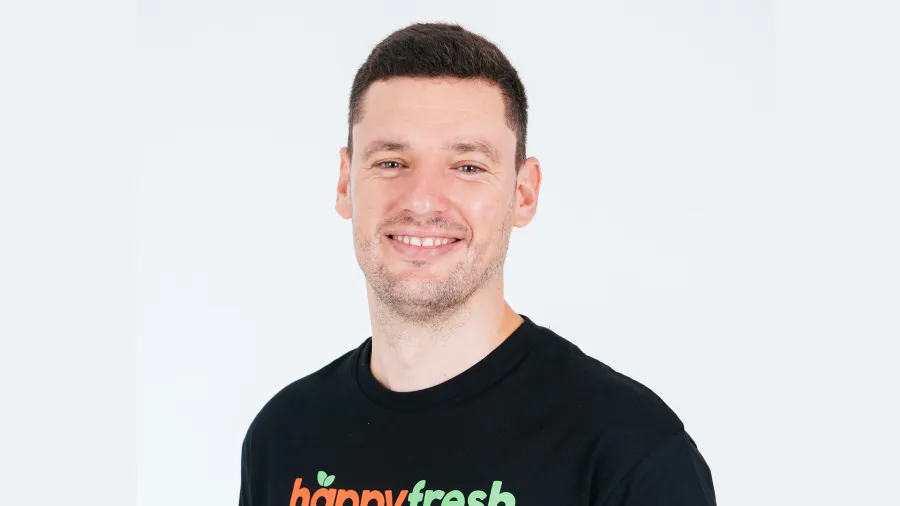
From the farm to your cart: This e-grocer delivers fresh produce
HappyFresh relies on its 6-year customer behaviour database in determining product offerings.
Fresh and never out-of-stock—this has been the cornerstone of HappyFresh’ strategy. And how does this e-grocery keep its massive 15,000 stock units of products fresh? HappyFresh CEO Guillian Segarra said that it is through sourcing directly from the farmers.
Through its digital store, HappyFresh Supermarket, the e-grocer not only offers fresh products but also free delivery. This enables the company to cope with the trends in consumer behaviours toward a healthy lifestyle.
Segarra spoke with Retail Asia and discussed what more can be expected from the e-grocer.
How has HappyFresh performed in 2021 and what are the factors that drove these results?
Both 2020 and 2021 have been our best years, so far, both in terms of overall newly-acquired customers and monthly active users. Also, in 2021 we delivered millions of orders. Compared to 2018, we were in the hundred-thousands range. We grew three or four times year on year.
The external factor for this is that the Southeast Asian region, especially Indonesia, was already going through a massive digital transformation. A Temasek article said that throughout 2020, over 50% to 60% of people actually tried groceries online for the first time.
There are internal factors, as well. We were probably the service in the groceries that benefited the most because we've been in the region for five to six years. We already had a recognised brand, a household brand. We had solid operations. More importantly, we already had the leadership position. When people think about groceries for the first time, HappyFresh is probably the household name that comes to mind, and that's why we had a lot of new customers coming then.
The second internal aspect is that we always focus on quality, customer experience, and delivering superior value propositions. A lot of the customers who tried for the first time continue using our services even after the lockdown. Now we have a large number of new users, and especially an even larger number of repeat users, which has driven growth throughout 2021 and the beginning of 2022.
Do you expect the same performance in 2022? Do you expect any challenges down the line?
We saw a shift in purchasing behaviour throughout 2020 and 2021 and it’s not going back. People are already used to shopping for groceries online. After you've done it more than once and you've gotten good service, good value for money, we just don't go back. For 2022, what we see is that all these new customers that came in the last two years will be staying with us and that's driving the growth.
This year, we are also aggressively expanding our newest service, HappyFresh Supermarket. As we have better control over things like branding, pricing, packaging, last-mile delivery, or opening hours, we can cater for more and more users. That's driving significant growth for us this year. At the beginning of this year, we’ve already seen it and we expect this to continue throughout 2022. If anything, we expect 2022 to be our best year thus far. I think it would be a combination of the HappyFresh Supermarket addressing a larger pool of customers or a larger addressable market, overall customer shifts, and the penetration of groceries that keep on increasing exponentially.
Can you tell us more about the HappyFresh Supermarket and how will this help the company's goals?
When you go into the HappyFresh app, you would see all our supermarket partners that we historically have and we are still going to work with them. They are a key part of our ecosystem. But you will also see a digital store called HappyFresh Supermarket. Within that store, you will be able to find anything around 15,000 products curated by using the five to six years of customer behaviour data, and understanding what products are made for your daily and weekly shopping. Those products will be offered to you at a very competitive pricing, high-quality source and with free delivery. We believe that by doing that, we are tackling a part of the market that is not addressed yet or is not served. These markets are where all people are looking for quality, especially for fresh products, but yet they also are very conscious about price. The fresh produce price is probably even below the wet market because we sourced directly from some of our partners that work with farmers.
When we look at the service level, you can get your order delivered within 30 minutes up to one hour, and we offer it for free. How do we manage to do that? That's the secret sauce of it. We build a network of fulfilment centres across the city that allows us to bring all these products. We work with some of our retailer partners' distributors and because we build this within the cities, we are very close to the customer, allowing us to deliver to you in 30 minutes. This also allowed us to have really strong quality control over the products, for example, having policies around plastic and packaging, which some of our retailer partners still don't have.
In the end, by doing that, we have full control from the brand, to the pricing, to the range, assortment, to the products, all the way to the service, quality packaging, and the customer experience. This for us is a really important initiative. As our volumes grow, we also need to start thinking about what would be next right. At the volumes that we're currently moving, we need to start to take our steps toward infrastructure sourcing and the supply chain makes a lot of sense.
HappyFresh is also pushing for grocery shopping that's done sustainably. What are your initiatives on this?
We believe that as you grow bigger as a company, your social responsibility should grow accordingly, as well. Because of this evolution of the business model, we start to have our infrastructure where we start working directly with suppliers, and farmers' supply chain, and here is where we can make a big difference. We have initiatives like plastic-free policies within our warehouses. We also have the GoGreen option at checkout, where we encourage customers to get eco-bags or carbon boxes, or nothing plastic-related.
We also work with different NGOs in Indonesia and Malaysia to work on food wastage. If we have any excess food that is close to expiration, we anticipate that and we donate this so the food doesn't go to waste. This is just the very first step that we started around six to 12 months ago and it now becomes even more important because we're working with supply chain, food, and transportation.
In terms of the grocery industry, what are the emerging trends you have observed amongst consumers and how does the company plan on catering to this?
There are a couple of trends that are emerging quite strongly in Southeast Asia. First, we care much more about what we eat. We are much more conscious about health and what we put in our bodies. That's translating into shopping habits shifting junk food to healthier products ranging from supplements to vegetables.
Number two, people in consumers care much more about where these products are sourced, and how these products have been produced. Have they been produced sustainably and have they been produced respecting animals and labourers? There is this growing consciousness around food quality and healthiness, and whether they were produced respecting the ecosystem, regulations, and if they are locally sourced or not.
We start to look at if we can source more locally produced products, and work closely with farmers. We also start to work with organically grown products. This is still at a very early stage. But being able to understand and ultimately offer products that have been fairly sourced and healthy, and you don't need to pay much more to get that quality would be key for groceries, online or offline, to drive and thrive within these trends.
What other new services will you be introducing this year?
Customers first wanted convenience and reliable service that can offer quality and fresh produce. That's what we focussed on in the beginning and we built that brand and that reputation. Second, customers wanted additional value for money without having to compromise on the quality of fresh produce. The answer to that is HappyFresh Supermarket.
I think customers also want to make sure that they are spoiled. We're working on things like our loyalty programmes, reward programmes, and a few other programmes around customers that usually and recurrently shop with us in order for them to get the best value for money moving forward.
What are the company's overall goals this year? Any expansion plans outside of Malaysia, Indonesia and Thailand?
We wanted to solidify and further increase our market leadership position in the markets where we operate. We believe that this year and next year will be incredibly critical for e-groceries and I think the players that would dominate the market would emerge within these couple of years. Hence, that would be our goal and how do we even further increase our market share.
In terms of expansion, we truly believe generally as a company that we decide expansion around the focus on quality-over-quantity. In our current markets Indonesia, Malaysia, and Thailand, we’re far from reaching any saturation when it comes to addressable markets. We might spend a lot of our time in our core markets. We are potentially going to other cities within those markets. Although we don't completely discard opportunistically looking at other markets, it is not necessarily our focus or immediate focus.
What more can we expect from the company for this year?
We would shift gears and change the pace. We're moving much faster and to a certain extent much bigger. That's a consequence of adjusting to how fast and big the market is becoming. Things or strategic initiatives that we thought we would push in one year or two years are coming already like HappyFresh Supermarket. We thought that rollout was going to take like six to 12 months, but we pushed it to around three months and we’ve rolled out around 15 facilities that cover almost 90% of the area. I believe the next 12 months would be incredibly pivotal for the e-grocery industry.



















 Advertise
Advertise






